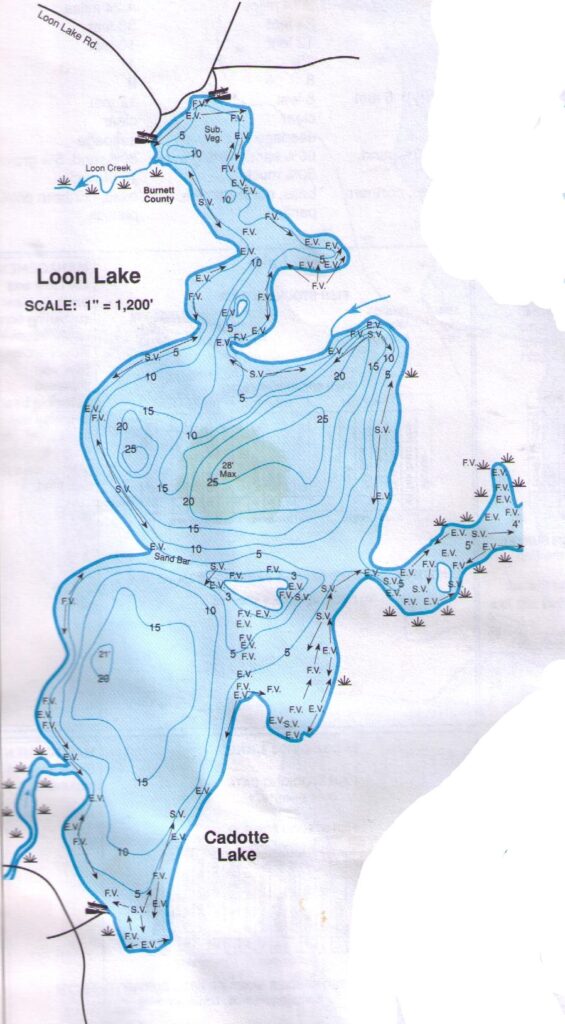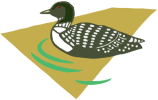Water Testing
LAKE WATER QUALITY – JERRY SURPRENANT Testing was done this summer during June, July and August by Jerry and Judy Surprenant. The Secchi disk test consists of dropping a white disk into the lake and determining at what depth of water you canno longer see the disk. During this summer’s tests, one set showed a depth of only 7.0 to 7.5 feet which is much less than most other tests. A similar test on Cadotte Lake showed a depth of only six feet. The weather was a little windy, but there were no unusual conditions that Jerry and Judy could see that would account for the reduced depths. Other tests during the summer were back to the normal ten to eleven feet. New satellites have been put into use that will coordinate their readings with results obtained during our testing to see if the satellite information would be sufficient to replace actual on-the water testing. More information about this will be available next summer.
For the last 20 years we have taken water samples an submitted them to the DNR for analysis. Each year 4 samples are taken spring, late June, July and August. In 2020 only 3 samples were taken due to COVID-19. The key measures are Total Phosphorus, Chlorophyll and Trophic State. The water clarity is also taken and measured in feet, using a black and white disc lower into the water. Over the last 20 years clearest recorded is 12 feet the lowest 7 feet. The last 5 years has averaged 8.5 feet.
Water Sampling Summary
Chart by Jerry Surprenant
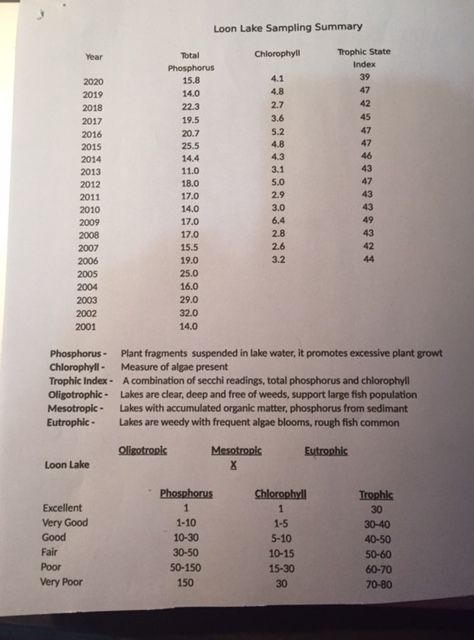
Invasive Species
LLPOA supports Clean Waters Clean Boats and maintains a Boat Cleaning & Decontamination Station at the public landing on the North end of the lake. We are always seeking volunteers to assist boaters using the facility as they put in and takeout their boats on higher traffic weekdays and weekends. Volunteers should contact Craig Campbell, (cncamp0906@yahoo.com) for more information and to volunteer.
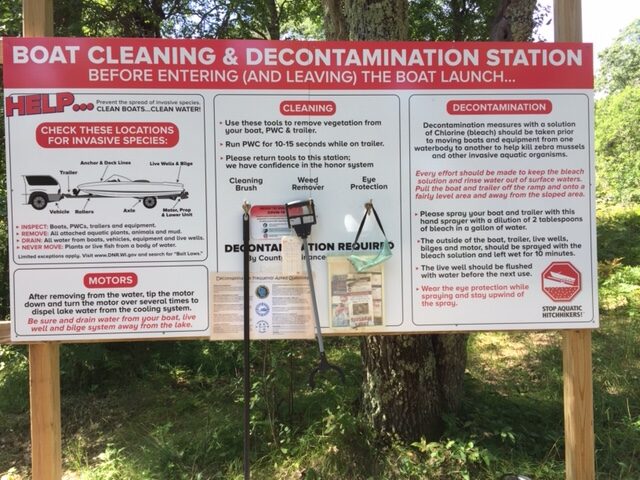

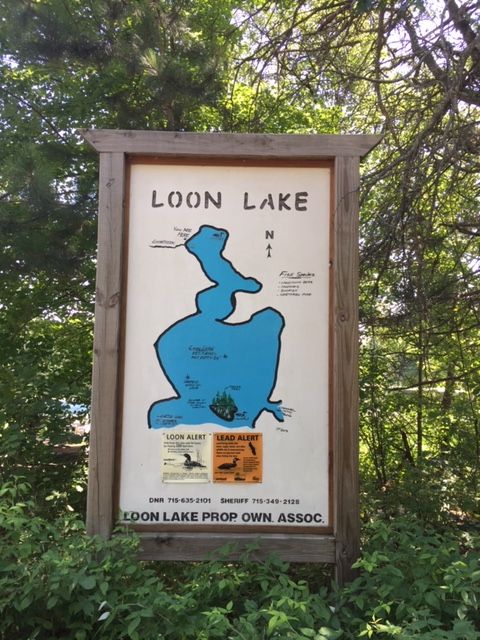
Q. What are the signs at the boat landing all about?
Preventing the spread of any Aquatic Invasive Species (AIS)
We have all heard of invasive species over the years, from Eurasian Water Milfoil to Asian Carp. Before they were always in someone else’s backyard. Now they are in our neighboring lakes (Big and Middle McKenzie) and threatening the quality of our local lakes. The following questions and answers should
help clarify why AIS are a threat to our lakes and what can be done to prevent their introduction into our waterways.
Q. What is a zebra mussel?
Zebra mussels are hard shell mussels initially brought to the Great Lakes in ballast water. Since being introduced to the U.S. they have been spread to inland waterways primarily by boaters. Zebra mussels are very prolific, producing anywhere from 500,000 to 1 million eggs per year per mussel. These eggs develop into microscopic larvae called veligers that float around in the top of the water column for 5-6 weeks. Due to their small size they are invisible to the naked eye and can be transported easily by an unsuspecting boater who transports them in bilges, live wells, motors, etc.
Q. Why are zebra mussels so detrimental to a lake?
Zebra mussels are very efficient at filtering water. An adult can filter over 1 quart of water per day. They filter out all the microscopic algae (phytoplankton) and tiny animals (zooplankton) that are the dietary staple of our native larvae and juvenile fish, creating competition for food sources at the lower end of the
food chain. Simple conclusion: if there isn’t any available food for the small fish, there be no small fish for larger fish.
The shells are sharp and wash up on shore rendering beaches unusable for fear of being cut while swimming or wading.
Q. Shouldn’t I be able to see a zebra mussel attached to my boat?
Adult zebra mussels are about 1-2 inches in diameter and should be visible if your boat was moored for a day or more in an infected waterway. Immature zebra mussels start out as small as a grain of sand and are hard to detect. Veligers (zebra mussel larvae) as mentioned previously are invisible to the naked eye and pose the largest threat of accidental transport by boaters.
Q. What can be done to prevent our lakes from being contaminated?
The best way to protect our lakes is to make sure AIS are not transported between waterways. Since boats have been proven to be the biggest culprit, Burnett County has passed a regulation requiring all boats be decontaminated before entering or exiting any waterway where a decontamination station is
present. All boats are to be decontaminated even if only used in the same lake. Violations of the regulation can result in fines.
Many lakes in the metro Twin Cities and other areas of Minnesota have been infected with various AIS. It is extremely important for those boats used in other lakes to be carefully decontaminated so as not to spread any aquatic invasive species to our local lakes. Loon and Cadotte Lakes have decontamination stations at all landings. Please put this resource to good
use as we all have a vested interest in keeping our lakes clean and free from AIS. Once contaminated it is very difficult and expensive, if at all possible, to rid the invasive from our waterways.
Q. What is involved in properly decontaminating a boat and motor?
Although 140 degree hot water sprayed with a high pressure sprayer is used on known infected lakes, a mild bleach solution (8.25% or 2 Tbsp per gallon) sprayed on and left for 10 minutes is sufficient for most applications. Full strength vinegar or household disinfectant sprays containing quaternary ammonium compounds such as Fantastik and Formula 409 will work well for interior applications if a person is concerned about using the weak bleach solution.
–Spray all aspects of the boat and motor with the bleach sprayer making sure the solution stays on for 10 Minutes.
—Make sure the motor has been lowered and allowed to drain. “Burp” the engine (turn over engine without starting it) to allow the water in the impeller to drain out.
—Remove the drain plug and drain any bilge water
—Spray bilge area with disinfectant as well.
—If a live well has been used, make sure the live well and water lines get disinfected as they will have some residual lake waters in them. You may want to rinse with clean water before next use.
—Check for any aquatic plants on boat, motor, and trailer. The smallest plant fragment can be a seed for the next lake.
—Jet ski. Spray outside as well as any place water can enter such as bilge, etc. Drain engine by tipping up trailer and running engine for 10-15 seconds to expel any lake water, similar to what is done when winterizing the watercraft.
—Fishing boats. As well as following instructions for live wells, fishing boats can have other areas that could be harboring AIS. Spray your anchor rope with disinfectant and any other area which may have lake water. Clean the mud and plants off your anchor. Remember any droplet of water could be harboring an
AIS villain. Don’t transport lake water between lakes in your minnow bucket as it could contain some form of AIS from the previous lake.
Q. I have heard zebra mussels clean up a lake. Isn’t that a good thing?
Yes, zebra mussels do a very efficient job of filtering water. In doing so, they alter nature’s balance that has been established for centuries. Increasing water parity allows more sunlight to penetrate depths and encourages more plant growth and possibly more algae blooms. Zebra mussels filter green algae but spit out blue green algae creating an imbalance in the water quality. Blue green algae can be toxic to humans and dogs. Furthermore the zebra mussel waste products sink to the bottom of the lake and cause oxygen depletion at those levels.
Q. What other forms of AIS are of a concern for the lakes?
Unfortunately there are numerous invasive species on the horizon. Besides Eurasian Milfoil, there is a worse relative starting to affect some lakes. Starry stonework and spiny water fleas are some of the other nasty threats. Spiny water fleas eat zooplankton that fish depend on but have sharp, barbed terminal spines that are sharp enough to puncture the lining of the predatory fish. They also create a gooey blob of eggs on fishing lines which is easily transported between lakes. The list seems to go on and on but by
proper decontamination the spread of invasive species can be controlled.
Q and A by Craig Campbell
